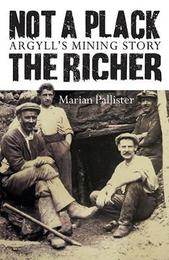
|
Not a Plack the Richer: Argyll's Mining Story
Paperback / softback
Main Details
| Title |
Not a Plack the Richer: Argyll's Mining Story
|
| Authors and Contributors |
By (author) Marian Pallister
|
| Physical Properties |
| Format:Paperback / softback | | Pages:240 | | Dimensions(mm): Height 195,Width 130 |
|
| Category/Genre | British and Irish History
Local history |
|---|
| ISBN/Barcode |
9781780275048
|
| Classifications | Dewey:338.2094142 |
|---|
| Audience | |
|---|
| Illustrations |
8 Plates, color
|
|
Publishing Details |
| Publisher |
Birlinn General
|
| Imprint |
Birlinn Ltd
|
| Publication Date |
5 July 2018 |
| Publication Country |
United Kingdom
|
Description
A fascinating exploration of a unique and little-known aspect of Argyll's past. Argyll is well known for its magnificent scenery, breathtaking coastline and picturesque villages. But hidden among its beautiful hills and glens and on its islands is evidence of an extraordinary industrial past. Minerals have been mined in Argyll for millennia, and from the 1700s lead, copper, zinc, silver, nickel and gold were sought by landowners as a way to exploit their estates, as well as by entrepreneurs and prospectors wanting to make a quick buck or, preferably, a considerable fortune. Mining spurred the development of the county's infrastructure, bringing bursts of prosperity to remote communities and a 'frontier spirit' redolent of the American West. In this book, Marian Pallister tells the story of Argyll's mining past. Her research into official records, letters and other documentary material is set beside the personal experience of those involved at all levels in the industry itself and the local communities whose lives it changed forever.
Author Biography
Marian Pallister has worked as a feature writer and commentator covering social issues in Scotland and round the world, particularly in disaster and war zones. She previously taught journalism at Napier University and is currently tutor in English subjects at Argyll College. She also founded a charity, ZamScotEd, which supports the education of vulnerable young people in Zambia.
Reviews'Those interested either in the history of mining or the social and economic development of Argyll should read this book. Indeed I would go further and say that it merits an even wider readership. It is a good example of not only how to research a local study but also how to present it to a wider readership' * Scottish Local History *
|